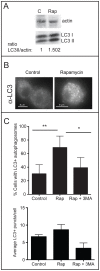Autophagic Killing Effects against Mycobacterium tuberculosis by Alveolar Macrophages from Young and Aged Rhesus Macaques
- PMID: 23825603
- PMCID: PMC3688994
- DOI: 10.1371/journal.pone.0066985
Autophagic Killing Effects against Mycobacterium tuberculosis by Alveolar Macrophages from Young and Aged Rhesus Macaques
Abstract
Non-human primates, notably rhesus macaques (Macaca mulatta, RM), provide a robust experimental model to investigate the immune response to and effective control of Mycobacterium tuberculosis infections. Changes in the function of immune cells and immunosenescence may contribute to the increased susceptibility of the elderly to tuberculosis. The goal of this study was to examine the impact of age on M. tuberculosis host-pathogen interactions following infection of primary alveolar macrophages derived from young and aged rhesus macaques. Of specific interest to us was whether the mycobactericidal capacity of autophagic macrophages was reduced in older animals since decreased autophagosome formation and autophagolysosomal fusion has been observed in other cells types of aged animals. Our data demonstrate that alveolar macrophages from old RM are as competent as those from young animals for autophagic clearance of M. tuberculosis infection and controlling mycobacterial replication. While our data do not reveal significant differences between alveolar macrophage responses to M. tuberculosis by young and old animals, these studies are the first to functionally characterize autophagic clearance of M. tuberculosis by alveolar macrophages from RM.
Conflict of interest statement
Figures




References
-
- Sturgill-Koszycki S, Schlesinger P, Chakraborty P, Haddix P, Collins H, et al. (1994) Lack of acidification in Mycobacterium phagosomes produced by exclusion of the vesicular proton-ATPase. Science 263: 678–681. - PubMed
-
- Via L, Deretic D, Ulmer R, Hibler N, Huber L, et al. (1997) Arrest of mycobacterial phagosome maturation is caused by a block in vesicle fusion between stages controlled by rab5 and rab7. J Biol Chem 272: 13326–13331. - PubMed
-
- Via L, Fratti R, McFalone M, Pagan-Ramos E, Deretic D, et al. (1998) Effects of cytokines on mycobacterial phagosome maturation. J Cell Sci 111: 897–905. - PubMed
Publication types
MeSH terms
Grants and funding
LinkOut - more resources
Full Text Sources
Other Literature Sources

